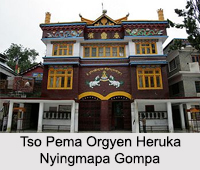 Tso Pema Orgyen Heru-kai Nyingmapa Gompa, also known as Tso Pema Nyingmapa Gompa is one of the most popular and oldest monasteries. It is situated on the banks of Tso Pema or Rewalsar Lake, which is a holy place of Guru Rinpoche in Mandi district of Himachal Pradesh. This monastery was built in 1960 by Wangdor Rinpoche and Dudjom Rinpoche.
Tso Pema Orgyen Heru-kai Nyingmapa Gompa, also known as Tso Pema Nyingmapa Gompa is one of the most popular and oldest monasteries. It is situated on the banks of Tso Pema or Rewalsar Lake, which is a holy place of Guru Rinpoche in Mandi district of Himachal Pradesh. This monastery was built in 1960 by Wangdor Rinpoche and Dudjom Rinpoche.
History of Tso Pema Orgyen Heru-kai Nyingmapa Gompa
It is anticipated that Wangdor Rinpoche in his 30 years course of meditation in the caves of Tso Pema, was joined by more than fifty yogis and yoginis. Resided in the caves they followed him for guidance and support. Then Wangdor Rinpoche helped Dudjom Rinpoche to build the monastery.
Visiting Spots around Tso Pema Orgyen Heru-kai Nyingmapa Gompa
The monastery contains a prayer hall and a museumthat preserves various exquisite murals. There is also a retreat center on the mountainand a monumental statue of Guru Rinpoche directly standing above the lake. Along with the Tso Pema Monastery, the nearby Drigung Kagyud Gompa monastery is also worth a visit.
This article is a stub. You can enrich by adding more information to it. Send your Write Up to content@indianetzone.com





















